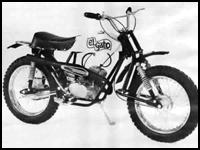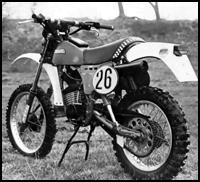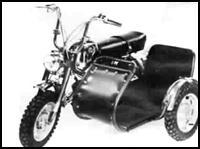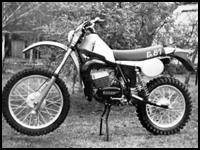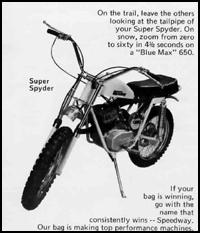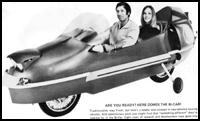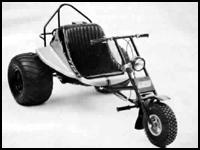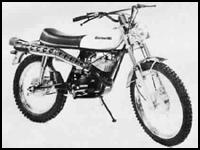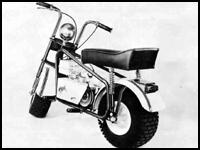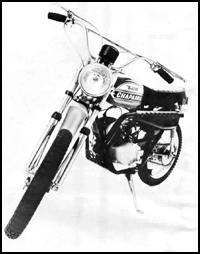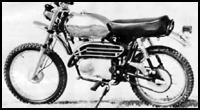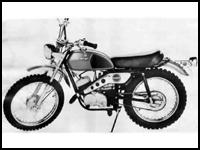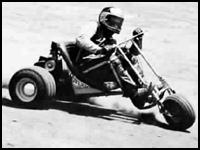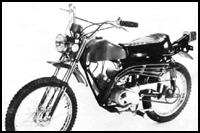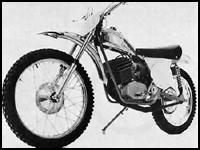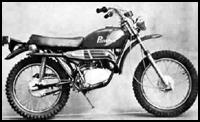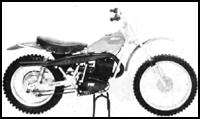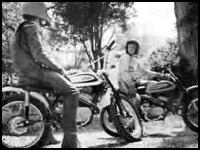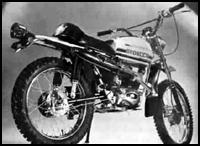|
Action Sports 920-996-9480 |
|
WEIRD BIKES OF THE PAST!
One day I was going through a bunch of really old magazines and literature with a friend.
He kept saying things like: "Whoa! What's that? I never heard of it." Or: "Man, that is one strange-looking
bike!" Or: "Jeez, that is incredibly ugly and more-than-bizarre!" So I gathered up a bunch of them and figured I'd share them
with you. As long as you're looking at these weird old bikes, take a casual test and see how many you recognize. If you get
about half, that means you've been in the sport a long time, and qualify as a "dirtbike historian" yourself. Have fun! EL GATO ALL-FAMILY MIDI-CYCLE The Muskin Corp. is introducing El Gato, a thoroughly tested all-family midi-cycle. Powered by an 80cc Fuji two-stroke,
single-cylinder engine, the bike delivers 6.6 hp, has a four-speed, constant-mesh transmission and curb weight of 125 pounds.
Well balanced on a 44-inch wheelbase, El Gato's overall length is 67 inches with seat height of 27 inches. The 3.00 x 16 knobby
tires give maximum traction. The machine's seat-tank combination is finished in chrome yellow. Leading link front and swing
arm rear suspension, front and rear internal expanding 105mm brakes, noise emission-approved spark arrester exhaust, flexible
fenders and folding footpegs complete the package. FANTIC CABALLERO 125RC Engine: Single-cylinder two-stroke, with piston-port induction BENELLI MIDI-SIDEHACK Cosmopolitan Motors has made available the world's first "midi-sidecar," powered
by the 65cc four-speed Dynamo series of midi-bikes. The sidecar features a 10-inch steel wheel and knobby tire, stainless
steel fender, plush velour upholstered seat, leg cowling and a hand rail. Though firmly affixed to the Dynamo frame, the sidecar
can be easily removed for servicing or solo riding. MOTO-GORI TR250 Engine: SWM/Rotax single-cylinder two-stroke with disc-valve induction SPEEDWAY SUPER SPYDER On the trail, leave the others looking at the tailpipe of your Super Spyder. If your All things considered, I never heard of a Super Spyder winning any race, anywhere. By the way, Speedway also offered
other models with fancy names, like the Scorpion and the more-than-aptly-named Widowmaker. THE BI-CAR Traditionalists may flinch, but here's
a totally new concept in two-wheeled touring vehicles. And adventurous souls just might find that "something different"
they're looking for in the Bi-Car. Eight years of research and development have gone into the Bi-Car, so it's no spur-of-the-moment
idea. Bell Vehicle, Inc., IS serious about the project, and has even more expansive plans for the future. The vehicle seats
two passengers in tandem and utilizes standard motorcycle controls. At lower speeds and when stopping, the Bi-Car features
a retractable landing gear that comes down to stabilize the machine. In addition to a sturdy, close-fitting shell, an optional
canopy offers protection from dust, rain, noise and wind. Shown is the Saturn 500 model; it's 9 feet, 10 inches long, 33 inches
wide and weighs 470 pounds. Powered by a 500cc, 60-hp engine that gets up to 40 mpg, Saturn models are in production and sell
from $1590 up. SPORTY SNOWCO TRI-SCAT The Snowco line of three-wheel vehicles offers utility as well as sport. And a front ski attachment which replaces
the front wheel permits year-around use. Sportiest is the Tri-Scat with metalflake fiberglass body (shown), leather-type bucket
seat, and low-bar, low-pressure ATV tires. It's available with 5-hp or 7-hp engine, and the 7-hp model comes equipped with
standard head lamp and roll bar. The 7-hp Tri-Scat is also available in a deluxe model with 12-V key starter, head- and taillights,
chrome front fork, roll bar and hubcaps. More utilitarian is the Nomad, also available with 5-hp or 7-hp engine, and equipped
with wide, low-pressure knobby tires. Headlight and roll bar are standard on the 7-hp model. Addition of an optional cargo
carrier makes the machine a utility vehicle for hunters, fishermen, farmers and many other users. The "baby" of
the line is the 2 1/2-hp Mini-Scat, produced especially for youngsters, but far from a toy. BENELLI BANSHEE Benelli's new midi-cycle is styled after
their well known Mini-Enduro. The Banshee has an all-new 90cc, five-speed two-stroke engine. Pirelli moto-cross tires (2.75
x 15") and enduro suspension smooth out the toughest terrain. Full electrics, battery, and a 44-inch wheelbase make the
Banshee street-legal. Other features include an upswept exhaust, skid plate, Dell'Orto concentric carburetor, radial cylinder
head finning, and performance that will embarrass many 125's. TRAIL BRONC ALL-TERRAIN TRAIL BIKE KIT - Heald, Inc., is now marketing a new Trail Bronc,
model VT-3. Company officials state that the VT-3 has been improved in performance, reliability and riding comfort over previous
models. Powered by a 172cc Tecumseh engine, the new Trail Bronc utilizes a sensitive torque converter transmission and heavy-duty
No. 40 chain in the final drive. A big 8 ? inch wide rear tire and 6 1/2-inch wide front tire provide the traction and stability
needed on the trail. Their low pressure design coupled with the telescoping front shocks, damped coil spring rear shocks and
large - padded seat smooth out the rough spots encountered in trail riding. The 8-inch ground clearance and engine skidpan
enable the bike to go over almost any obstacle. Full steel fenders both front and rear (decorated with a sporty racing stripe)
serve to keep mud and dirt off both bike and rider. There are just two simple controls, a hand-operated brake lever and safe
spring return twistgrip throttle. A stop button is also mounted on the chrome plated handlebars. The handlebars telescope
down for easier transport and storage. The bike can be ordered with alternator engine for powering the optional road approved
lighting accessory. A front ski is also available so the machine can be used the year around. This rugged bike is ideal for
hunting, fishing, camping, farm and ranch, work or play. The Trail Bronc comes in money-saving, easy-to-assemble kit form. CHAPARRAL "FAMILYWEIGHT" MINI-CYCLES Chaparral Industries, fastest growing major
snowmobile company in the country, has recently added mini-cycles to its product line. The bikes will be available in three
models: the Bullet ST80 (shown), the Bullet T80, and the Bullet T172. Built primarily for trail riding, the ST80 and T80 are
four-speed bikes powered by a two-stroke, 80cc Fuji engine that pumps out 7.5 hp at 6800 rpm. The T172 has a 172cc Tecumseh
four-stroke powerplant and torque-converter for shift-free riding. Top-of-the-line ST80 weighs 125 pounds, has hydraulic front
suspension with rear coil springs. On this model, lights, horn and speedo package are standard. Trail-ready T80 version is
stripped for action, has torque-tuned exhaust with spark arrester. RAIDER ENDURO Marco's new Enduro model, designed for trail enthusiasts,
is available in two versions. Both are four-speed two-strokes: a 60cc, 150-pound, 5.5-hp model, and a 90cc 169-pounder that
provides 8.5 hp. Other dimensions are the same. Wheelbase is 42 inches, ground clearance 7 3/4 inches, seat height 28 inches,
peg height 9 inches. A Mikuni carb is standard, and fuel capacity is 2 1/2 gallons. The bike incorporates a double-loop frame,
Ceriani-type suspension, 6-volt battery, mufflered exhaust. Tires are 2.50 x 17-inch front, 2.50 x 15-inch rear. Suggested
retail price of the 90cc Raider Enduro is $389; for the 60cc model it's $325. RUPP 80CC INTERMEDIATE BIKE Here's a first from Rupp - their RMT 80. Primarily for off-road
use, it's also street-legal in 45 states. Designed like a big bike, the RMT 80 has a flat-out torque curve through the entire
4000-7500 rpm range. Motorcycle-type muffler is quiet but performance tuned; built-in spark arrester makes it woods-approved.
There's a 29 1/2-degree front fork rake for precise turning, plus smooth oil-damped front and rear coil suspension. Tires
are Rupp-designed road knobbies. The RMT 80's frame is a double downtube, single backbone type made from 4130 chrome moly.
Bike weighs in at 135 pounds. Fenders are flexible; lower yoke and brake pedal are forged. Frame-mounted gas tank is cushioned,
footpegs are retractable. High/low SAE-approved headlight, 80-mph speedo, horn, two-way kill switch are standard. So are brake-
and taillight, as are six Class A reflectors. TWO CHEETAHS - TAKE YOUR CHOICE Recreational Technology has designed a pair of Cheetahs, the 7-hp
Model RT-250 (shown) and the 5-hp RT-200. They're powered by Tecumseh four-stroke 250cc and 200cc engines, respectively, with
pull-cord starting and magneto ignition. Both utilize automatic torque-converter transmissions. Knobby tires are 21-inch diameter,
11 inches wide, on 8-inch rims, Inflation is 2 psi for off-road, 5 psi for hard surface use. Hand-operated Kelsey-Hayes brakes
are caliper types on 8-inch diameter discs. Fuel capacity: 1 gallon (tank is chrome-plated on the RT-250). Reinforced 7/8-inch
O.D. steel tubes, mig-welded, comprise the frame. Head- and taillight are standard on Cheetah 250. Wheelbase is 45 inches,
ground clearance 10 inches, length 66 inches, width 30 inches. Weight: 150 pounds. A.P.E. DUNECYCLE Starting a couple of years ago with one model, Allied Pacific Engineered Products
now offer six race-proven Dunecycles, with horsepower ratings that range from 5 to 14. The three-wheeled vehicles, first introduced
by A.P.E., started a whole new form of competition, and the firm's machines have continued their superiority - both in organized
racing and off-road pleasure riding. Not a motorcycle, not a dune buggy, they're in a unique category that appeals to people
with leanings toward either two or four wheels. Space limitations preclude listing of all models and complete specifications.
For example, you can get them with Briggs & Stratton, Tecumseh or McCulloch engines; lights are available on some but
not on others; tire sizes vary as do ground clearances; three models have front suspension and three don't, etc. GEMINI BOSS 80 San Tong has jumped into the two-wheeled
field with a pair of Gemini mini-bikes (50cc and 80cc) and their larger Gemini Boss 80 mini-cycle (shown). This machine puts
out 8.5 hp at 7000 rpm from its two-stroke, single-cylinder, rotary valve engine, has oil injection and four-speed transmission.
It utilizes magneto ignition and telescopic front forks. Tuned exhaust system, lights and speedo are standard. Wheelbase is
46 inches, ground clearance 7 inches, seat height 30.2 inches. Tires front and rear are 2.50 x 15-inch, with optional 2.25
x 17 front. In addition to their Gemini bike line, the firm also supplies frames, sans engines, for mini-bikes. TYRAN 125 MX DISPLACEMENT: 122 cc PANTHER 175 BLACK SHADOW PURPOSE: Dual-purpose POWER DYNE - GRINGO 300/250 TRANSMISSION:
5-speed, left side shift ALSPORT-STEEN X-100 PURPOSE: Racing, trail riding BRONCCO APACHE 100 PURPOSE: Enduros, trail riding
|
|||||||||||||||||||||||||||||||||||||||||||||||||||||||||||||||
|
Enter supporting content here Action Sports * W7170 Hwy 10-114* Menasha, WI * USA * 54952 Phone: (920) 996-9480 Fax: (920) 996-9480
|
|||||||||||||||||||||||||||||||||||||||||||||||||||||||||||||||

